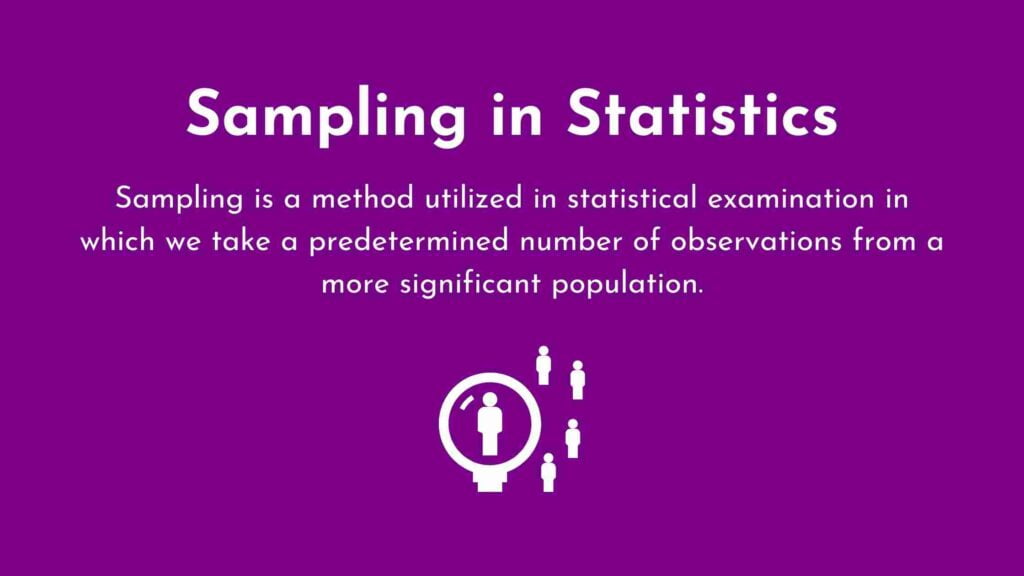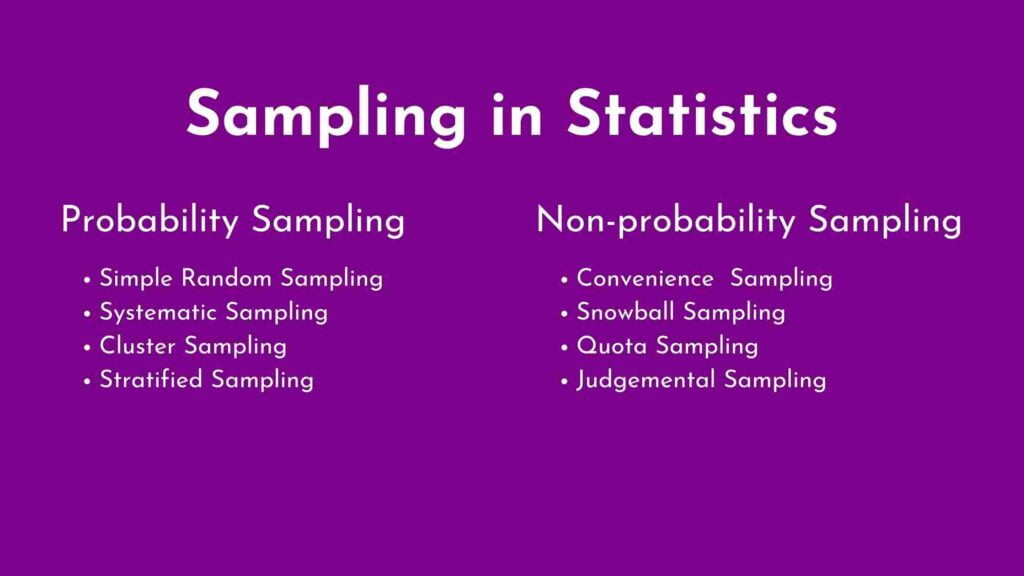Learn about Sampling in Statistics — the difference between Sample and Population, Different types of Sampling in Statistics in detail.
Sampling is a method utilized in statistical examination in which we take a predetermined number of observations from a more significant population.
To understand sampling, we must first discuss the difference between Sample and Population.
Sample:
- It’s difficult for the Analyst or the Researcher to collect possible detail from the entire group. Instead, they choose a small group from the whole group.
- Samples are the subset of the Population that participates in research and represents the Population.
- Samples come from the Population.
Population:
- It is a collection from which a sample comes.
- It is an exact quantity involved in the entire study.
Example of Sample and Population
To develop a vaccine for Covid, several companies have come with the research and vaccines they test to read efficacy. The vaccine is for the entire human race, and the Population for this study is all of us. Companies can’t make a study on the whole human race. Hence to make the vaccination quicker, they conduct clinical trials based on a closed group called Sample. That way, the research is quick, efficient and cost-effective.
What is Sampling in Statistics?
Sampling is a method that allows researchers or analysts to infer knowledge about the Population based on Sample results without needing to investigate every individual.

Advantages of Sampling
- Reduces the number of individuals in studies
- Reduces cost
- Reduces workload
- High-quality information to arrive at a better conclusion from the results
Categories of Sampling in Statistics
- Probability Sampling
- Non-probability Sampling
Probability Sampling
- In this sampling, every member of the Population has an equal chance of participating in the study.
- For example, when we start flipping a coin at every instance, there is an equal chance of getting a “head” or a “tail” irrespective of how many times we flip the coin.
Types of Probability Sampling in Statistics

Simple Random Sampling:
- Every member of the study has an equal chance of selection.
- Selection depends on chance and randomness.
- Simple Random Sampling is also called Simple Random Sampling.
Example:
Consider a meeting that has people from different age groups, ethnicity, sex, colour and creed. If we have to create a sample using Simple Random Sampling, we choose individuals without any bias and randomly.
Systematic Sampling
- In Systematic Sampling, we choose the first member randomly and subsequent members systematically
Example:
Consider a class with roll numbers 1 to 40, and if we have to create a Sample by Systematic Sampling method, we choose the first student randomly, say 10. Subsequently, we have to select members like every 4th student from Roll Number 10.
Cluster Sampling
- Researcher/analyst divide Population into a group called Clusters
- Groups can be externally homogenous and internally heterogenous
- The analyst creates random clusters
- Select a member from a single cluster based on Simple Random Clustering
Stratified Sampling
- Even in stratified sampling, we create a strata group based on specific characteristics and the select member from each stratum.
Example:
Consider a meeting having people of different ages, sex, ethnicity. In Stratified Sampling, we group people based on age, sex, race. Then we select members from each stratum.
Non-probability Sampling
- Sampling-based on non-random criteria
- Not every individual in the Population has a chance of being included in the study.
- This method is easier and cheaper to implement, but it cannot provide valid statistical inferences.
Types of Non-probability Sampling in Statistics
Convenience Sampling:
- Based on convenience
- Sampling happens to be most accessible to analysts or researchers.
- It’s an easy way of sampling and cost-effective but no way to prove if it’s an accurate representation of the entire Population.
- Convenience Sampling is also called Accidental Sampling.
Snowball Sampling:
- The first Sample is selected based on random selection.
- The first Sample then selects the subsequent selections.
- Snowball Sampling is also called Network Sampling.
Quota Sampling
- Used by Market Researchers.
- Samples are Tailor Selected.
- Selection based on the proportion of the trait of the Population
Purposive / Judgemental Sampling in Statistics
- Selection based on Judgement
- Selection based on Analyst or Researchers
- Used by Media or Public Surveys
Now that you have read about Sampling in Statistics, you can check our post on Distribution in Statistics. If you wish to learn Data Analytics, check the R Programming course by Ampersand Academy.
